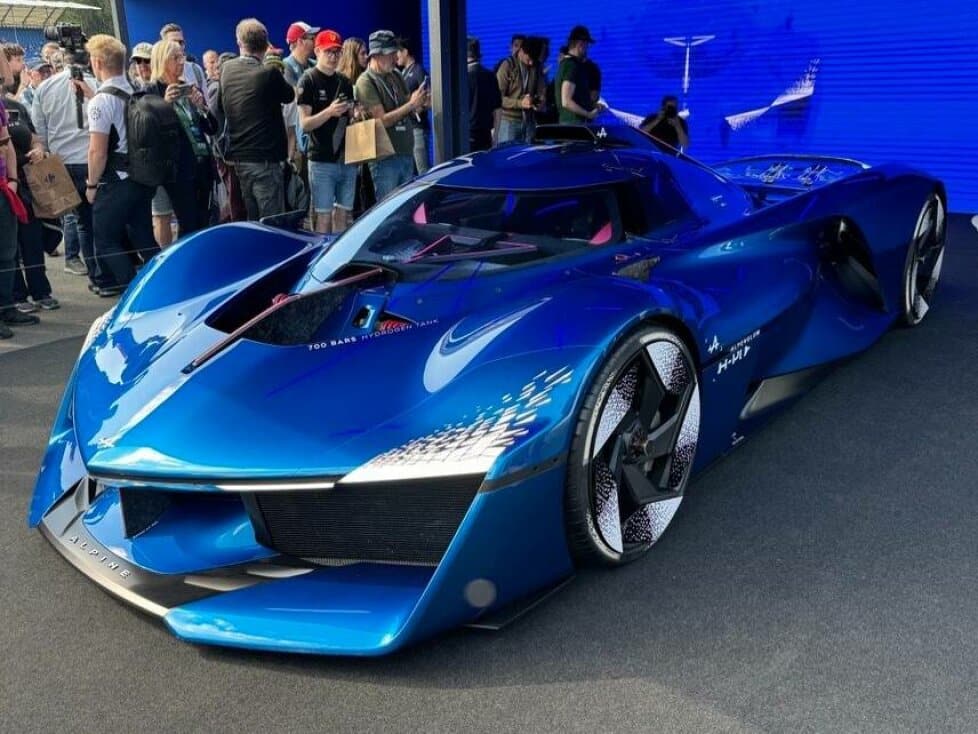Alpine has presented the real version of the Alpenglow with a hydrogen combustion engine – but the first drive before the race could not take place
This world premiere went wrong: due to electronics problems, the Alpine Alpenglow HY4, the full name of the hydrogen prototype, was unable to complete the planned demonstration drive in the run-up to the 6-hour Spa-Francorchamps race of the World Endurance Championship (WEC)
“The car has already completed 700 test kilometers, but this can happen to prototypes with innovative technologies. We will work on this problem and now prepare the car for a demonstration run during the 24 Hours of Le Mans”,
The race car was officially unveiled on Friday morning. The almost emission-free car is visually very similar to the study presented at the Paris Motor Show in 2022. In contrast to this, the Alpenglow HY4 has a turbocharged inline four-cylinder engine, hence the 4 in the name. The HY stands for Hydrogenium, i.e. hydrogen.
The 2.0-liter turbo engine produces 340 hp at a speed of 7,000 rpm and is fed from three hydrogen tanks, each containing 2.1 kilograms of hydrogen at a pressure of 700 bar. The power is transferred to the road via a sequential gearbox. However, this is only a temporary solution, as a V6 engine is due to make its debut at the end of the year.
“We know that hydrogen will be an important step in the decarbonization of the next generation of endurance vehicles and could also be important for Formula 1 racing cars, especially with the transition to liquid storage for more compactness and performance,” says Alpine Motorsport boss Bruno Famin.
“The Alpenglow concept illustrates this perfectly and is a true technology laboratory for the development of tomorrow’s hydrogen engines. “
Two-seater up to 270 km/h fast
The biggest change compared to the study is the switch to the two-seater concept. As with many vehicles in the Le Mans scene, the driver sits on the right-hand side. He is surrounded by three voluminous tanks for the gaseous hydrogen, which is stored at a pressure of 700 bar. In the medium term, a solution for the liquid storage of the fuel is to be used.
Alpine is at the forefront of the Renault Group’s efforts to preserve the combustion engine in the long term. For motorsport with a high proportion of full load, the combustion engine has an advantage over the fuel cell for weight reasons, but according to Alpine, the technology is also an “extremely promising solution” for road use.
Interestingly, the vehicle is based on a Ligier LMP3 chassis – just like the Ligier JS2 RH2 from Bosch, which we will also be reporting on in the next few days. With the current four-cylinder engine, a top speed of 270 km/h is possible
ALPENGLOW HY4: D-2 pic.twitter.com/Ns8LQVqEq1
– Alpine Cars FR (@AlpineCarsFR) May 8, 2024
Despite various modifications, particularly to the crash structure, the spectacular, futuristic look of the “blue Batmobile” is retained. Alpine’s Head of Design Antony Villain is particularly proud of this. The preservation of the transparent rear spoiler was particularly important to the design team.
“Since the creation of the Alpine Alpenglow concept car, which was unveiled in Paris in 2022, we have been looking forward to fulfilling the promise associated with such a unique object: to bring it to the racetrack. That has now become a reality,” he says.
“The Alpine Alpenglow HY4 can now show the full performance that the original concept car visually hinted at: a real race car with all the visual and aural expression you would expect.





